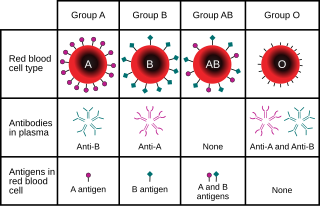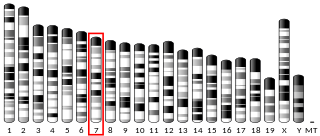Related Research Articles

In immunology, autoimmunity is the system of immune responses of an organism against its own healthy cells, tissues and other normal body constituents. Any disease resulting from this type of immune response is termed an "autoimmune disease". Prominent examples include celiac disease, post-infectious IBS, diabetes mellitus type 1, Henoch–Schönlein purpura (HSP) sarcoidosis, systemic lupus erythematosus (SLE), Sjögren syndrome, eosinophilic granulomatosis with polyangiitis, Hashimoto's thyroiditis, Graves' disease, idiopathic thrombocytopenic purpura, Addison's disease, rheumatoid arthritis (RA), ankylosing spondylitis, polymyositis (PM), dermatomyositis (DM), and multiple sclerosis (MS). Autoimmune diseases are very often treated with steroids.

The human leukocyte antigen (HLA) system or complex is a complex of genes on chromosome 6 in humans which encode cell-surface proteins responsible for regulation of the immune system. The HLA system is also known as the human version of the major histocompatibility complex (MHC) found in many animals.

Sialic acids are a class of alpha-keto acid sugars with a nine-carbon backbone. The term "sialic acid" was first introduced by Swedish biochemist Gunnar Blix in 1952. The most common member of this group is N-acetylneuraminic acid found in animals and some prokaryotes.

The ABO blood group system is used to denote the presence of one, both, or neither of the A and B antigens on erythrocytes. For human blood transfusions, it is the most important of the 44 different blood type classification systems currently recognized by the International Society of Blood Transfusions (ISBT) as of December 2022. A mismatch in this, or any other serotype, can cause a potentially fatal adverse reaction after a transfusion, or an unwanted immune response to an organ transplant. The associated anti-A and anti-B antibodies are usually IgM antibodies, produced in the first years of life by sensitization to environmental substances such as food, bacteria, and viruses.

CTLA-4 or CTLA4, also known as CD152, is a protein receptor that functions as an immune checkpoint and downregulates immune responses. CTLA-4 is constitutively expressed in regulatory T cells but only upregulated in conventional T cells after activation – a phenomenon which is particularly notable in cancers. It acts as an "off" switch when bound to CD80 or CD86 on the surface of antigen-presenting cells.

Dihydrolipoyl transacetylase is an enzyme component of the multienzyme pyruvate dehydrogenase complex. The pyruvate dehydrogenase complex is responsible for the pyruvate decarboxylation step that links glycolysis to the citric acid cycle. This involves the transformation of pyruvate from glycolysis into acetyl-CoA which is then used in the citric acid cycle to carry out cellular respiration.
Autoimmune lymphoproliferative syndrome (ALPS) is a form of lymphoproliferative disorder (LPDs). It affects lymphocyte apoptosis.

B-lymphocyte antigen CD20 or CD20 is expressed on the surface of all B-cells beginning at the pro-B phase and progressively increasing in concentration until maturity.
Siglecs(Sialic acid-binding immunoglobulin-type lectins) are cell surface proteins that bind sialic acid. They are found primarily on the surface of immune cells and are a subset of the I-type lectins. There are 14 different mammalian Siglecs, providing an array of different functions based on cell surface receptor-ligand interactions.

CD22, or cluster of differentiation-22, is a molecule belonging to the SIGLEC family of lectins. It is found on the surface of mature B cells and to a lesser extent on some immature B cells. Generally speaking, CD22 is a regulatory molecule that prevents the overactivation of the immune system and the development of autoimmune diseases.

CD33 or Siglec-3 is a transmembrane receptor expressed on cells of myeloid lineage. It is usually considered myeloid-specific, but it can also be found on some lymphoid cells.
HLA-DR52 is an HLA-DR serotype that recognizes gene products of HLA-DRB3 locus. Three allele groups can produce 35 isoforms.

The enzyme N-acetylneuraminate lyase catalyzes the chemical reaction

Protein tyrosine phosphatase non-receptor type 22 (PTPN22) is a cytoplasmatic protein encoded by gene PTPN22 and a member of PEST family of protein tyrosine phosphatases. This protein is also called "PEST-domain Enriched Phosphatase" ("PEP") or "Lymphoid phosphatase" ("LYP"). The name LYP is used strictly for the human protein encoded by PTPN22, but the name PEP is used only for its mouse homolog. However, both proteins have similar biological functions and show 70% identity in amino acid sequence. PTPN22 functions as a negative regulator of T cell receptor (TCR) signaling, which maintains homeostasis of T cell compartment.

Cytidine monophospho-N-acetylneuraminic acid hydroxylase (Cmah) is an enzyme that is encoded by the CMAH gene. In most mammals, the enzyme hydroxylates N-acetylneuraminic acid (Neu5Ac), producing N-glycolylneuraminic acid (Neu5Gc). Neu5Ac and Neu5Gc are mammalian glycans that compose the glycocalyx, especially in sialoglycoproteins, which are part of the sialic acid family. The CMAH equivalent in humans is a pseudogene (CMAHP); there is no detectable Neu5Gc in normal human tissue. This deficiency has a number of proposed effects on humans, including increased brain growth and improved self-recognition by the human immune system. Incorporation of Neu5Gc from red meat and dairy into human tissues has been linked to chronic disease, including type-2 diabetes and chronic inflammation.

Sialic acid-binding Ig-like lectin 8 is a protein that in humans is encoded by the SIGLEC8 gene. This gene is located on chromosome 19q13.4, about 330 kb downstream of the SIGLEC9 gene. Within the siglec family of transmembrane proteins, Siglec-8 belongs to the CD33-related siglec subfamily, a subfamily that has undergone rapid evolution.

Sialic acid-binding Ig-like lectin 10 is a protein that in humans is encoded by the SIGLEC10 gene. Siglec-G is often referred to as the murine paralog of human Siglec-10

Anti-double stranded DNA (Anti-dsDNA) antibodies are a group of anti-nuclear antibodies (ANA) the target antigen of which is double stranded DNA. Blood tests such as enzyme-linked immunosorbent assay (ELISA) and immunofluorescence are routinely performed to detect anti-dsDNA antibodies in diagnostic laboratories. They are highly diagnostic of systemic lupus erythematosus (SLE) and are implicated in the pathogenesis of lupus nephritis.

N-Glycolylneuraminic acid (Neu5Gc) is a sialic acid molecule found in most non-human mammals. Humans cannot synthesize Neu5Gc because the human gene CMAH is irreversibly mutated, though it is found in other apes. It is absent in human tissues because of inactivation of gene encoding CMP-N-acetylneuraminic acid hydroxylase. The gene CMAH encodes for CMP-N-acetylneuraminic acid hydroxylase, which is the enzyme responsible for CMP-Neu5Gc from CMP-N-acetylneuraminic (CMP-Neu5Ac) acid. This loss of CMAH is estimated to have occurred 2-3 million years ago, just before the emergence of the genus Homo.

Sialic acid-binding Ig-like lectin 6 is a protein that in humans is encoded by the SIGLEC6 gene. The gene was originally named CD33L (CD33-like) due to similarities between these genes but later became known as OB-BP1 due to its ability to bind to this factor and, finally, SIGLEC6 as the sixth member of the SIGLEC family of receptors to be identified. The protein has also been given the CD designation CD327.
References
- ↑ Cariappa A, Takematsu H, Liu H, Diaz S, Haider K, Boboila C, Kalloo G, Connole M, Shi HN, Varki N, Varki A, Pillai S (2009). "B cell antigen receptor signal strength and peripheral B cell development are regulated by a 9-O-acetyl sialic acid esterase". J. Exp. Med. 206 (1): 125–38. doi:10.1084/jem.20081399. PMC 2626685 . PMID 19103880.
- 1 2 3 4 Ira Surolia; et al. (8 July 2010). "Functionally defective germline variants of sialic acid acetylesterase in autoimmunity". Nature . 466 (7303): 243–247. Bibcode:2010Natur.466..243S. doi:10.1038/nature09115. PMC 2900412 . PMID 20555325.
- ↑ "SIAE sialic acid acetylesterase [Homo sapiens (Human)] - Gene - NCBI".
- ↑ Zhu H, Chan HC, Zhou Z, Li J, Zhu H, Yin L, Xu M, Cheng L, Sha J (2004). "A gene encoding sialic-acid-specific 9-O-acetylesterase found in human adult testis". J. Biomed. Biotechnol. 2004 (3): 130–136. doi: 10.1155/S1110724304307084 . PMC 551583 . PMID 15292578.
- ↑ "OMIM Entry - # 613551 - AUTOIMMUNE DISEASE, SUSCEPTIBILITY TO, 6; AIS6".
- ↑ Yamamoto M, Iguchi G, Bando H, Fukuoka H, Suda K, Takahashi M, Nishizawa H, Matsumoto R, Tojo K, Mokubo A, Ogata T, Takahashi Y (2014). "A missense single-nucleotide polymorphism in the sialic acid acetylesterase (SIAE) gene is associated with anti-PIT-1 antibody syndrome". Endocr. J. 61 (6): 641–4. doi: 10.1507/endocrj.ej13-0539 . PMID 24748456.
- ↑ Gan EH, MacArthur K, Mitchell AL, Pearce SH (2012). "The role of functionally defective rare germline variants of sialic acid acetylesterase in autoimmune Addison's disease". Eur. J. Endocrinol. 167 (6): 825–8. doi:10.1530/EJE-12-0579. PMC 3494867 . PMID 23011869.
- Garcia-Sastre A, Villar E, Manuguerra JC, Hannoun C, Cabezas JA (January 1991). "Activity of influenza C virus O-acetylesterase with O-acetyl-containing compounds". Biochem. J. 273 (2): 435–41. doi:10.1042/bj2730435. PMC 1149864 . PMID 1991039.
- Shukla AK, Schauer R (1982). "High performance liquid chromatography of enzymes of sialic acid metabolism". Hoppe-Seyler's Z. Physiol. Chem. 363: 1039–1040.